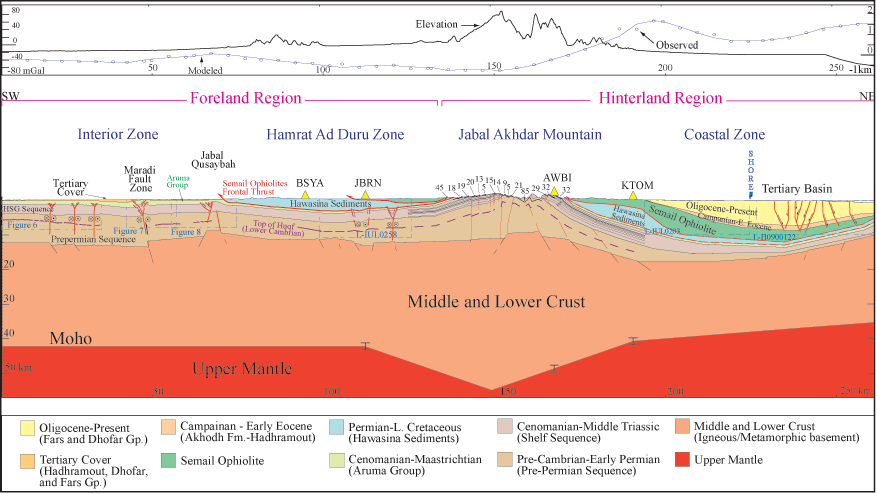
The unique tectonic setting of the Oman Mountains and the Semail Ophiolite, together with ongoing hydrocarbon exploration, have focused geological research on the sedimentary and ophiolite stratigraphy of Oman. However, there have been few investigations of the crustal-scale structure of the eastern Arabian continental margin. In order to rectify this omission, we made a 255-km-long, southwesterly oriented crustal transect of the Oman Mountains from the Coastal Zone to the interior Foreland via the 3,000-m-high Jebel Akhdar. The model for the upper 8 km of the crust was constrained using 152 km of 2-D seismic reflection profiles, 15 exploratory wells, and 1:100,000- to 1:250,000-scale geological maps. Receiver-function analysis of teleseismic earthquake waveform data from three temporary digital seismic stations gave the first reliable estimates of depth-to-Moho. Bouguer gravity modeling provided further evidence of depths to the Moho and metamorphic basement.
Four principal results were obtained from the transect. (1) An interpreted mountain root beneath Jebel Akhdar has a lateral extent of about 60 km along the transect. The depth-to-Moho of 41 to 44 km about 25 km southwest of Jebel Akhdar increased to 48 to 51 km on its northeastern side but decreased to 39 to 42 km beneath the coastal plain farther to the northeast. (2) The average depth to the metamorphic basement was inferred from Bouguer gravity modeling to be 9 km in the core of Jebel Akhdar and immediately to the southwest. A relatively shallow depth-to-basement of 7 to 8 km coincided with the Jebel Qusaybah anticline south of the Hamrat Ad Duru Range. (3) Based on surface, subsurface, and gravity modeling, the Nakhl Ophiolite block extends seaward for approximately 80 km from its most southerly outcrop. It has an average thickness of about 5 km, whereas ophiolite south of Jebel Akhdar is only 1 km thick. The underlying Hawasina Sediments are between 2 and 3 km thick in the Hamrat Ad Duru Zone, and 2 km thick in the Coastal Zone. (4) Southwest of Jebel Akhdar, reactivated NW-oriented strike-slip basement faults that deformed Miocene to Pliocene sediments were inferred from the interpretation of seismic reflection profiles.
Click here to view a PDF of the published paper
Figure 16.
The complete transect of the crust and parts of the upper mantle from the interior of Oman in the southwest, across the Jabal Akhdar Mountain and in the hinterland in the northeast. Also, shown observed and model Bouguer gravity values, with the corresponding elevation along the transect. The transect depicts important stratigraphic sequences and formations, and structural relations. Red lines indicate faults and black arrows indicate relative motion along the fault. 2-D seismic profiles location along the transect are indicated by dashed blue and green rectangles. The Semail Ophiolites frontal thrust is delineated at the sole of the Hawasina Sediments, and a bold red line indicates the sole of the igneous ophiolite body. Dip information of the Jabal Akhdar Mountain are shown along the surface of the structure. The transect also shows locations of deployed seismic stations (yellow triangles) and the corresponding, projected, impinging locations are shown as error bars.
